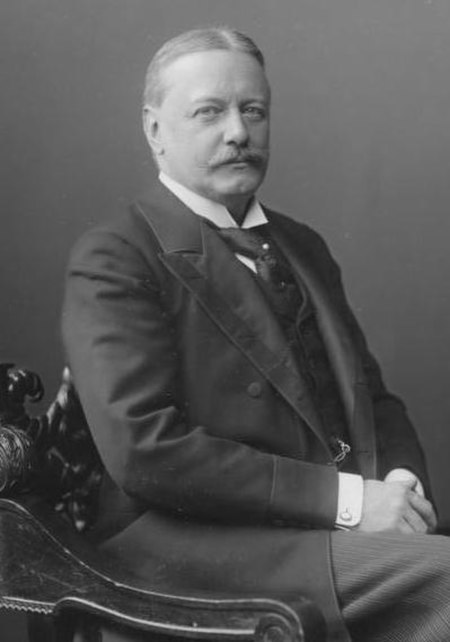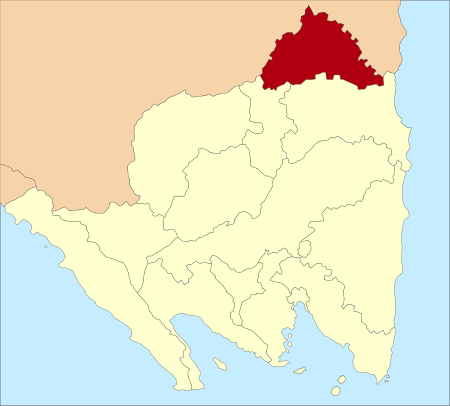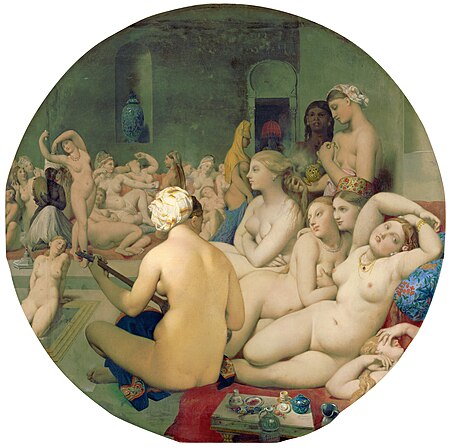Portaledge
|
Read other articles:

Pangeran Bernhard von Bülow Kanselir JermanMasa jabatan17 Oktober 1900 – 14 Juli 1909Penguasa monarkiWilhelm IIPendahuluChlodwig zu Hohenlohe-SchillingsfurstPenggantiTheobald von Bethmann HollwegMenteri-Presiden PrusiaMasa jabatan17 Oktober 1900 – 14 Juli 1909PendahuluChlodwig von Hohenlohe-SchillingsfürstPenggantiTheobald von Bethmann HollwegMenteri Luar Negeri Jerman Kekaisaran Jerman Masa jabatanOktober 1897 – 16 Oktober 1900KanselirChlodwig von Hohenl…

Norwegian musician You can help expand this article with text translated from the corresponding article in Norwegian. (February 2018) Click [show] for important translation instructions. View a machine-translated version of the Norwegian article. Machine translation, like DeepL or Google Translate, is a useful starting point for translations, but translators must revise errors as necessary and confirm that the translation is accurate, rather than simply copy-pasting machine-translated text …

نهر النعامين المنطقة البلد فلسطين الخصائص الطول 11 كيلومتر المصب خليج حيفا مساحة الحوض 70 كيلومتر مربع تعديل مصدري - تعديل نهر النعامين نهر دائم تجري فيه المياه على مدار السنة ولا يتجاوز طوله 9 كم. وهو من أنهار شمال غرب فلسطين وأوديته. ولا يتعدى هذا النهر منطقة …

قناة الجديد شعار قناة الجديد معلومات عامة النوع منوعة المدير تحسين خياط تاريخ التأسيس 1992 البلد لبنان اللغة عربية اسم قديم نيو تي في(بالإنجليزية: New TV) المقر الرسمي بيروت الموقع الرسمي http://www.aljadeed.tv نايل سات التردد: 11296الاستقطاب: رأسيمعدل الرمز: 27500التصحيح: 5/6 عبر الس…

Untuk kegunaan lain, lihat Mesuji. Artikel ini memuat Surat Lampung. Tanpa dukungan multibahasa, Anda mungkin akan melihat tanda tanya, tanda kotak, atau karakter lain selain dari Surat Lampung. Kabupaten MesujiKabupatenTranskripsi bahasa daerah • Lampung • JawaꦩꦼꦱꦸꦗꦶDari atas, kiri ke kanan; Kantor Bupati Mesuji; Simpang Susun Way Kenanga di Jalan Tol Trans-Sumatra, Kec. Way Serdang; Tugu pengantin di Simpang Pematang LambangMotto…

Jean-Claude VerpilleuxBorn(1798-05-02)2 May 1798Rive-de-GierDied13 October 1875(1875-10-13) (aged 77)Saint-Martin-la-PlaineNationalityFrenchOccupation(s)Engineer, inventorKnown forLocomotives, Grapple boats Jean-Claude Verpilleux (2 May 1798 – 13 October 1875) was a French mine laborer who became a leading engineer, manufacturer and inventor. He was involved in the design of early railway locomotives, and invented innovative steam-powered grapple boats driven by traction wheels runni…

American basketball player Jim LineLine from the 1948 KentuckianPersonal informationBorn(1926-01-19)January 19, 1926Port Royal, Pennsylvania, U.S.DiedJanuary 24, 2013(2013-01-24) (aged 87)Russell, Kansas, U.S.Listed height6 ft 2 in (1.88 m)Listed weight185 lb (84 kg)Career informationHigh schoolNorth (Akron, Ohio)CollegeKentucky (1946–1950)NBA draft1950: 4th round, 45th overall pickSelected by the Indianapolis OlympiansPositionForwardCareer highlights and awards 2…

English political scientist (1924–2022) SirDavid ButlerCBE FBABorn(1924-10-17)17 October 1924London, EnglandDied8 November 2022(2022-11-08) (aged 98)Oxfordshire, EnglandKnown forPsephologySpouse Marilyn Evans (m. 1962; died 2014)[1]Children3AwardsKnight Bachelor (2011) Sir David Edgeworth Butler CBE FBA (17 October 1924 – 8 November 2022) was an English political scientist who specialised in psephology, the study o…

Village in Warmian-Masurian Voivodeship, PolandNawiadyVillageNawiadyCoordinates: 53°43′N 21°19′E / 53.717°N 21.317°E / 53.717; 21.317Country PolandVoivodeshipWarmian-MasurianCountyMrągowoGminaPiecki Nawiady [naˈvjadɨ] is a village in the administrative district of Gmina Piecki, within Mrągowo County, Warmian-Masurian Voivodeship, in northern Poland.[1] It lies approximately 4 kilometres (2 mi) south-west of Piecki, 17 km (11 mi) sou…

الرقم التسلسلي القياسي الدولي نوع من معرف منشور [لغات أخرى]، ووسائط، ومعيار تقانة الاختصار (بالإنجليزية: ISSN) الموقع الرسمي الموقع الرسمي الرقم التسلسلي القياسي الدولي للدوريات[1] أو الرقم الدولي الموحد للدوريات [2]ويعرف إختصارا بـ ردمد…

Australian federal electoral division Australian electorate BarkerAustralian House of Representatives DivisionMapInteractive map of boundariesCreated1903MPTony PasinPartyLiberalNamesakeCollet BarkerElectors123,518 (2022)Area63,886 km2 (24,666.5 sq mi)DemographicRuralThe Division of Barker is an Australian electoral division in the south-east of South Australia. The division was established on 2 October 1903, when South Australia's original single multi-member division was spl…

1990 studio album by Judy CollinsFires of EdenStudio album by Judy CollinsReleasedSeptember 1990GenrePop rockfolkLength49:00LabelColumbiaProducerJoel DornLucy SimonJudy Collins chronology Sanity and Grace(1989) Fires of Eden(1990) Baby's Bedtime(1990) Singles from Fires of Eden Fires of EdenReleased: October 1990 Professional ratingsReview scoresSourceRatingAllMusic[1]Encyclopedia of Popular Music[2]Entertainment WeeklyB[3] Fires of Eden is the eighteenth studio a…

الحمام التركي معلومات فنية الفنان وسيط property غير متوفر. تاريخ إنشاء العمل 1862[1] نوع العمل فن عُري، وفن الحياة اليومية الموضوع وسيط property غير متوفر. التيار استشراق، ورومانسية[2]، والحركة الكلاسيكية الحديثة[2] المالك الدولة الفرنسية [لغات…

Bài viết này cần thêm chú thích nguồn gốc để kiểm chứng thông tin. Mời bạn giúp hoàn thiện bài viết này bằng cách bổ sung chú thích tới các nguồn đáng tin cậy. Các nội dung không có nguồn có thể bị nghi ngờ và xóa bỏ. Cự GiảiBiểu tượng Hoàng ĐạoCon cuaKhoảng thời gian22 tháng 6 - 22 tháng 7Chòm saoCự GiảiNguyên tốNướcPhẩm chất Hoàng ĐạoThống lĩnhChủ tinhMặt TrăngVượng tinhSao Mộc…

The Ensemble instrumental National du Mali, 2008. Vieux Farka Touré (right) and Valery Assouan are two international known musicians from Mali. The photograph is from a concert in Oslo in 2016. The music of Mali is, like that of most African nations, ethnically diverse, but one influence predominates: that of the ancient Mali Empire of the Mandinka (from c. 1230 to c. 1600). Mande people (Bambara, Mandinka, Soninke) make up around 50% of Mali's population; other ethnic groups include the Fula (…

Green gemstone, a beryl variety For other uses, see Emerald (disambiguation). EmeraldEmerald crystal from Muzo, ColombiaGeneralCategoryBeryl varietyFormula(repeating unit)Be3Al2(SiO3)6Crystal systemHexagonal (6/m 2/m 2/m) Space group: P6/mсcSpace group(6/m 2/m 2/m) – dihexagonal dipyramidalUnit cella = 9.21 Å, c = 9.19 Å; Z = 2IdentificationFormula mass537.50ColorBluish green to greenCrystal habitMassive to well CrystallineCleavageImperfect on the [0001]FractureConchoidalMohs scale hardness…

Australian cities by population 1. Sydney (5.450m)2. Melbourne (5.207m)3. Brisbane (2.707m)4. Perth (2.309m)5. Adelaide (1.446m)6. Gold Coast (735k)7. Newcastle (527k)8. Canberra (467k)12. Geelong (302k)13. Hobart (254k)14. Townsville (187k)15. Cairns (161k)16. Darwin (151k)class=notpageimage| Australian cities (GCCSAs, bolded; SUAs) by population (rounded to the nearest thousand)Not shown on the map:9. Sunshine Coast (408k)10. Central Coast (348k)11. Wollongong (314k)17. Toowoomba (150k)18. Bal…

Victor J. PapanekLahir(1923-11-23)23 November 1923Wina, AustriaMeninggal10 Januari 1998(1998-01-10) (umur 74)Lawrence, KansasKebangsaanAmerika SerikatAlmamaterCooper Union;Massachusetts Institute of TechnologyPekerjaanArsitekPraktikJ.L. Constant Professor of Architecture and Design Victor J. Papanek (22 November 1923, Vienna – 10 January 1998, Lawrence, Kansas) adalah seorang desainer dan guru yang menjadi pendukung kuat dari desain sosial dan ekologis bertanggung jawab produk, peralatan,…

Spanish actress and model In this Spanish name, the first or paternal surname is Toledo and the second or maternal family name is Machín. Goya ToledoAt the 32nd Goya Awards in 2018BornGregoria Micaela Toledo Machín (1969-09-24) 24 September 1969 (age 54)Arrecife, Lanzarote, Canary Islands, SpainEducationCristina Rota School of Dramatic ArtsOccupation(s)Actress, modelYears active1993–presentSpouse Craig Ross (m. 2014)[1]PartnerOlivier M…

American TV series or program CBS StorybreakCBS Storybreak logo, as seen on the show's opening sequence.Presented byBob Keeshan (1985–1989)Malcolm-Jamal Warner (1993–1994)Country of originUnited StatesAustraliaOriginal languageEnglishNo. of seasons3No. of episodes26ProductionRunning time30 minutesProduction companiesSouthern Star/Hanna-Barbera AustraliaCBS Entertainment ProductionsOriginal releaseNetworkCBSReleaseMarch 30, 1985 (1985-03-30) –January 28, 1989 (1989-01-28) CBS…





